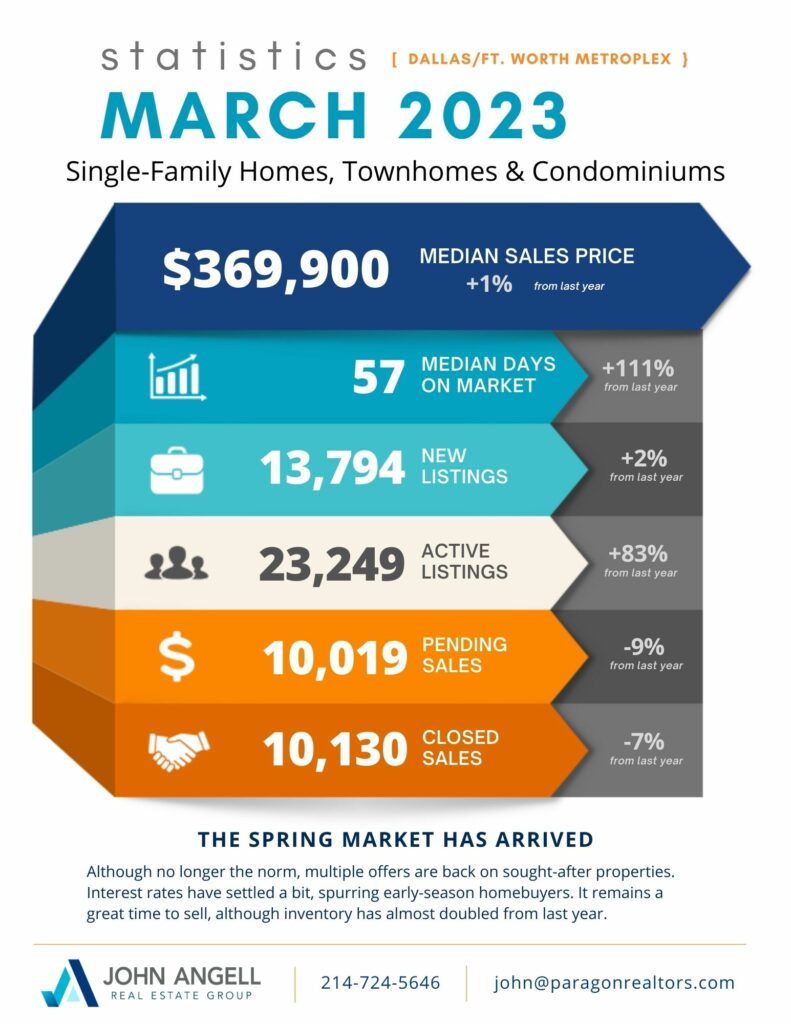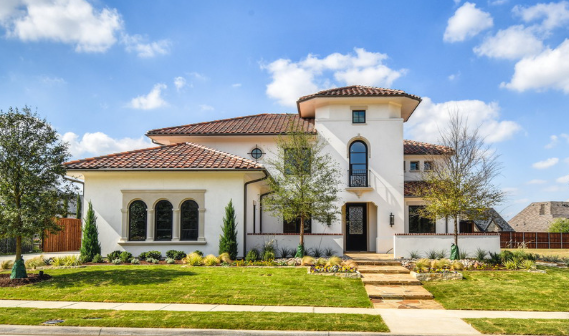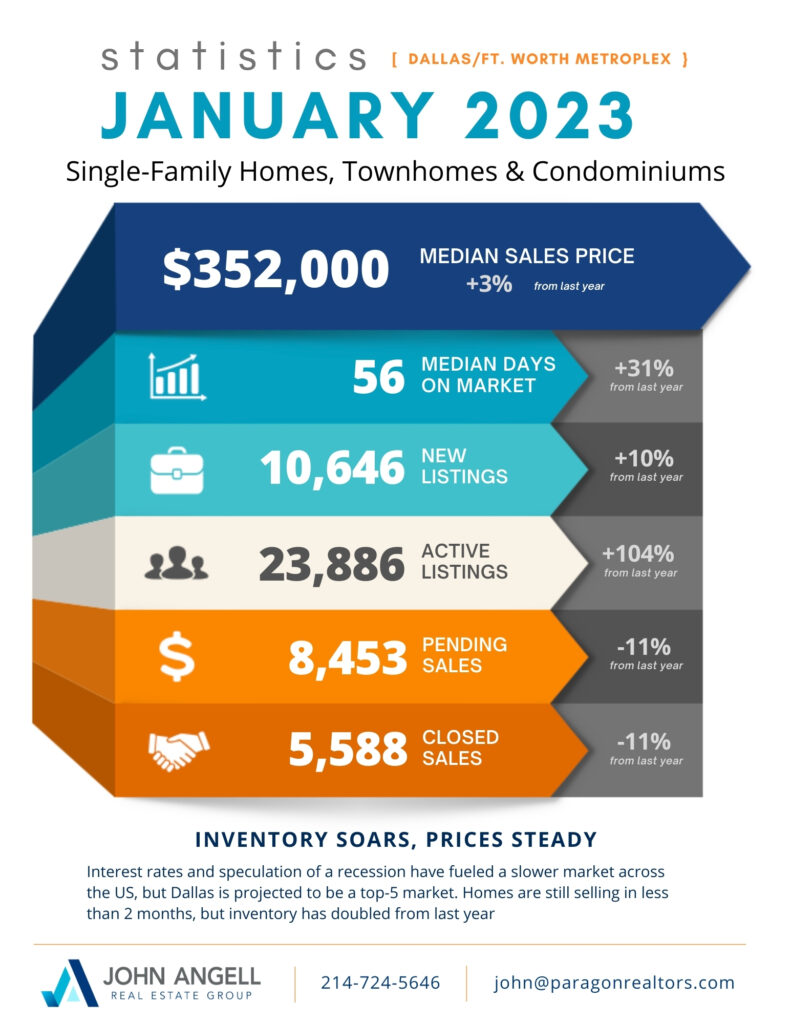
Architectural Corner: Spanish Revival
A classic architectural style found all over the world, Spanish Colonial first appeared in the Americas in the 1600s when Spanish settlers arrived, using local resources like adobe with a stucco finish for both interior and exterior walls, and clay tile roofs. While the Colonial period ended in the 1800s, the style was revived in the 1900s, becoming very popular with homebuilders.
Best suited for warm climates due to their adobe/stucco construction, Spanish Revival also features small and infrequent windows which facilitate airflow, wooden support beams, very few (if any) decoration, and typically an interior or exterior courtyard complete with an outdoor kitchen that prevents unduly heating the home’s interior.
A great many higher-end new construction homes in Dallas’ most premier neighborhoods are Spanish Revival.

Vague Specifics – March 2023
In a lot of ways it feels like 2008 all over again. Uncertainty dominates the business world, and it’s invariably affecting the real estate market. Interest rates dropped a bit with the collapse of Silicon Valley Bank; the Fed hopes a little more liquidity to banking will help. What’s different from the crash of 2008? Quite a bit actually.
Sidebar: I’m going to point out here the therapeutic effect of expressing frustration on a computer and deleting it. I’ve written this paragraph a half-dozen times raging about various political an economic figures, then wisely deleted them because it would end up pissing someone off.
Needless to say the real estate market was among the chief causes of the 2008 crash, in 2023 it’s a symptom. I’m not into predicting the future, but we can all be fortunate that Dallas is going to be one of the top performers in the nation yet again. What that looks like I don’t know, but thus far we’re seeing real reflections of 2016 and 2017, which were good but not great years.
I took a trip down to New Orleans the weekend of the 18th to see a show. Anyone who has never been to the French Quarter owes themself the trip, but don’t expect to be there longer than a couple of days. It reminds me a lot of the West End, with turn of the 20th century buildings that have been endlessly repurposed, reconfigured and reconstructed. Every night it serves as a drunken playground to the United States, and every morning it is cleaned up and made ready for the next night. There’s a really cool energy to it, albeit dirty and certainly not a place I could live. Among the people I met was political strategist Donna Brazile. She was a very interesting, extraordinarily intelligent lady. Great handshaker.
Architectural Corner: Shingle Style

From 1880-1900 a very monochrome style of house, reminiscent of Queen Anne architecture, rose to prominence, gaining notoriety for the heavy employment of shingles on walls, gable ends, curving towers and porch columns. It was appropriately named Shingle Style. Although it never gained the popularity of Queen Anne, it nonetheless spread from New England all over the United States.
In addition to shingled walls and roofs, Shingle Style featured expansive front porches, asymmetrical designs, irregular, moderately pitched roofs, and polygonal or round shingled towers.
It’s becoming a running joke at this point because he seems to have done it all, but yes, Frank Lloyd Wright did significant dabbling in Shingle Style.
Spring Cleaning Your Home Office

Let me start with the fact I am notorious for my disorganized, messy office, so I’m writing this article as much for myself as I am for you.
So many people moved home full-time during the pandemic began 3 years ago; many have continued working from home full-time to this day. While it was a easy transition to some, to other it’s taken a toll on their productivity, and maybe it’s time to take the spring cleaning spirit to your home office.
1) Remember It’s An Office – Home offices can easily become the catch-all for mail, bills, kids soccer gear, golf clubs, etc. If your home office is truly your work station and you use it regularly, treat it as one. No superfluous junk items, boxes or clutter. It is your temple to do work.
2) Reasonable Minimalism – In a perfect world, your office would consist of a clean desktop, your computer, printer, and organizing pieces, but there are some things you use all the time. If you use a notebook, box of envelopes, roll of stamps, etc on a regular basis, don’t let organization impede efficiency, but don’t be afraid to have a place for them when you’re done.
4) Different Areas, Different Tasks – If you do regular tasks requiring different spaces, organize appropriately. Be it a computer station, mailing station or research station, consider if your work flows from one task to the next and plan accordingly.
5) Don’t Forget Your Health – We no longer live in the days of the vanilla workspace. If you have back issues, consider a Varidesk that can be used standing up. It’s a rare person who couldn’t use more steps, there are plenty of apps on your phone or computer that can remind you to take a break and stretch your legs. If you want to make posture a priority, consider a resistance ball instead of your standard desk chair.
Vague Specifics – February 2023
If you look the most recent MLS statistics, the signs are all over the place. Median days on market is still very low comparative to historic averages, but market inventory has doubled and interest rates have certainly stretched home affordability. While I’ve been told we’ll see rates in the upper 5’s this spring and summer, recent economic reports have shown that current rates are not cooling down inflation. It would appear that the “soft landing” we were hoping for will turn into a recession. To those of us who remember the Great Recession, it’s unlikely we’ll see anything like that. Real estate was a if not the primary driver then, now the market slowdown is just a byproduct of more money that has ever been printed in human history being pumped into the US economy.
If there is a positive statistic to the market leveling off, it’s home affordability. Dallas was historically one of the most affordable major metropolitan areas in the United States (probably due in part to our crippling summers and lack of natural topography…). Since the 80’s, however, DFW has worked very hard to present a very diverse economy, and the benefits are being reaped in the form of mass migration to the area. Unfortunately, basic rules of supply and demand have driven up home prices because as the old real estate idiom says, “They ain’t making any more dirt.”.

A housing index of 100 means the median income home can afford the median-priced home. We’re hovering slightly below that right now, and it’s not being helped by the slow return to normal homebuilding rates. It’s likely going to drop a bit over the next few months as it does the first half of every year, but I wouldn’t be surprised if it eclipses 100 in the winter, which is when many are predicting the recession is going to arrive. Hopefully I’m wrong.
MLS Statistics – January 2023

Getting Your Lawn Ready for Spring

The jury is out on what our lawns are going to look like following a particularly hot and brutal summer, followed by several deep winter freezes. As a man obsessed with his St. Augustine, it may be a rebuilding year.
1) Clear All Debris – Now that the roots (or what remains of them) no longer need insulation from the cold, they need as much ventilation and exposure to sunlight as possible. Some lawns form a thick thatch over the soil that especially needs to be raked or removed by a de-thatcher. Also, airflow helps prevent disease and rot.
2) Aerate – I have to admit I’ve never done this, but given the density of our North Texas soil, it only makes sense that compacted areas are hard for grass to take root. They sell those funny aerating shoes on Amazon, or if you value your time (and dignity) consider buying or renting a power aerator.
3) Seek & Destroy Crabgrass – Crabgrass is a scourge to any healthy lawn and can choke out the grass you want. Applying a pre-emergent in very early March is advisable.
4) Check Your Sprinkler System – It was a brutal summer (in case you somehow forgot) and the odds are you saw dead spots on your lawn. Have you planted any new landscaping plants that may be blocking your sprinkler heads? Run all zones and make sure you’re getting maximum coverage.
5) Hold off on Fertilizing – North Texas god king of herbology Neil Sperry recommends waiting until April 15th to get the most out of fertilizing your lawn. This doesn’t mean hold off on pre-emergent, weeds sprout early and often.
Vague Specifics – January 2023
The steroid-infused, powerlifting champion market of 2020-2022 is over and into the new market of 2023 we go. Higher interest rates, a seasonal cooldown and looming recession have put the brakes on the hottest real estate market in DFW history. Let me reiterate that while I’ll miss the short contract periods and sellers giddly as schoolgirls by the offers they receive, it was wholly necessary. It’s going to take a long time for wages to catch up with prices.
What does that mean for you’re considering selling? A return to reality, mostly. It means you’ll have to pay attention to the market analysis I provide you, that the hardest part of my job isn’t going to be preparing the spreadsheet to facilitate choosing between 20 offers, and darn it means negotiating. The below graph is fascinating.

Does this mean the days of wheeling-and-dealing are back? In some instances yes, but it also means sellers need to be realistic about asking prices and not price speculatively. While it’s amazing we’ve touched 2012 levels of sales-price-to-original-list-price, it doesn’t mean every house you see will be willing to drop their price to 92% of list. Also, if you bought your house in mid-2022, especially if you went over list price and issued an appraisal waiver, you’ll likely need to stay put for a few years. The rule of thumb used to be you could sell your house and make a decent profit if you lived in it for 3-5 years, it appears to be the rule of thumb yet again.
All this said, it is the best time in years to buy. Rates are going to drop at some point and another mini-sellers run will begin. You have more inventory than you have had in several years from which to choose, and there are creative ways to buy down interest rates or just wait for them to drop and then refinance.
MLS Statistics – December 2022


